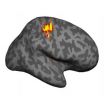(Press-News.org) Spanish National Cancer Research Centre (CNIO) researchers Alfonso Valencia, Director of the Structural Biology and Biocomputing Programme and David de Juan, jointly with Florencio Pazos, from the Spanish National Centre for Biotechnology (CNB-CSIC), publish a review on the latest computational methods that, based on evolutionary principles, are revolutionising the field of analysis and prediction of protein structure, function and protein-protein interactions, as well as the short- and long-term expectations for the field.
"The computational and mathematical analysis tools that study how proteins evolve in a coordinated fashion —a process known as molecular coevolution— have undergone important changes over the past few years", explains Valencia.
This revolution in the study of microscale evolution is allowing researchers to predict interactions between proteins and to understand the structural changes that take place in these molecules. It also represents the basis for understanding how mutations caused by diseases such as cancer or neurodegenerative disease affect their underlying molecular framework.
Proteins —just like the different species at the macroscopic level, via competitive or symbiotic interactions— do not act in an isolated manner but rather coordinate amongst themselves in order to carry out their functional roles. These biological relationships explain why there is a tendency in evolution to introduce coordinated changes in proteins, which allow for the preservation and modulation of these relationships.
"The development of new, more powerful and more reliable mathematical methods than those available in the 1990s is allowing us to explore these biological problems at the molecular level, and provide a deeper vision of the Darwinian process," says Valencia. "These methods based on coevolution are like a telescope, helping us to observe and understand biological and molecular processes."
MORE THAN 20 YEARS OF RESEARCH PREDICTING MOLECULAR RELATIONSHIPS
In the revision, the authors describe those mathematical methods that, based on the evolution of pairs of proteins, are capable of predicting molecular interactions at different levels of complexity.
These methods include those approaches from the 1990s that predicted contact points between proteins; those that allow us to understand binding selectivity between very similar proteins -or ones that belong to the same family- and their ligands; or even, at a deeper level of complexity, those that predict interaction networks between the thousands of proteins that make up cells.
Over the last 20 years, Valencia's team has led several lines of research related to this field, many of which are still being studied by many other groups and in which his team continues to be a world leader.
"In 2012, we published a new set of predictions on the specificity of the binding of the Ras oncogene to other proteins. The tool was based on coevolution methods that we had developed a couple of years ago, and that are now being widely explored by other groups," explains Valencia. The Ras protein family is associated with a wide spectrum of cancers, so learning the language it uses with other proteins that are important for cells might open avenues for the development of novel drugs.
The authors of the study foresee a promising future for this field, in which bioinformatics programmers, physicists, biologists and mathematicians join forces in order to describe the complexity of protein dynamics.
"In the long term, we hope that unifying these methods will help us to manipulate or create new drugs that selectively target abnormal cells and therefore reduce side effects," says de Juan.
###Reference article:
Emerging methods in protein co-evolution. David de Juan, Florencio Pazos, Alfonso Valencia. Nature Reviews Genetics (2013). doi: 10.1038/nrg3414
Molecular coordination in evolution: A review in 'Nature Reviews Genetics'
A CNIO team, led by Alfonso Valencia, has revised the latest methodologies for studying the evolution and interaction of proteins, as well as future applications for selective drug development
2013-03-05
ELSE PRESS RELEASES FROM THIS DATE:
How cells optimize the functioning of their power plants
2013-03-05
Mitochondria, which are probably derived from distant bacterial ancestors incorporated into our cells, have their own DNA. However, we know little about how these organelles, which convert oxygen and consumed nutrients into energy, regulate the expression of their own genes. Jean-Claude Martinou, professor at the University of Geneva (UNIGE), Switzerland, and his team, have discovered the existence of compartments at the heart of mitochondria, consisting of hundreds of different proteins. It is here that RNA molecules (the many copies made from DNA) come together to be ...
Single gene might explain dramatic differences among people with schizophrenia
2013-03-05
March 5, 2013 (Toronto) – Some of the dramatic differences seen among patients with schizophrenia may be explained by a single gene that regulates a group of other schizophrenia risk genes. These findings appear in a new imaging-genetics study from the Centre for Addiction and Mental Health (CAMH).
The study revealed that people with schizophrenia who had a particular version of the microRNA-137 gene (or MIR137), tended to develop the illness at a younger age and had distinct brain features – both associated with poorer outcomes – compared to patients who did not have ...
Viruses: More survival tricks than previously thought
2013-03-05
Among eukaryotes with modified nuclear genetic codes, viruses are unknown. Until now it had been believed that the modifications to the genetic code effectively prevented new viral infections. However, researchers have now reported the first example of a virus that can be shown to have crossed the boundary from organisms using the standard genetic code to those with an alternate genetic code.
"The finding is significant because it means that virus-host co-evolution after a genetic code shift can be more extensive than previously thought", said researcher Derek J. Taylor, ...
West Nile virus passes from female to eggs, but less so from larvae to adults
2013-03-05
In California Culex mosquitoes are considered to be the principle vectors of West Nile virus (WNV), which infects birds, humans, and other mammals during the summer. In addition, these mosquitoes may also serve as overwintering reservoir hosts as the virus is passed "vertically" from female mosquito to egg, then larva, and then adult.
To find out how often this happens, California researchers monitored WNV in mosquitoes in the field and in the lab, and observed how the virus is transmitted between generations and between insect stages. The results are published in the ...
Remains of extinct giant camel discovered in High Arctic by Canadian Museum of Nature
2013-03-05
Ottawa, Canada, March 5, 2013 - A research team led by the Canadian Museum of Nature has identified the first evidence for an extinct giant camel in Canada's High Arctic. The discovery is based on 30 fossil fragments of a leg bone found on Ellesmere Island, Nunavut and represents the most northerly record for early camels, whose ancestors are known to have originated in North America some 45 million years ago.
The fossils were collected over three summer field seasons (2006, 2008 and 2010) and are about three-and-a-half million years old, dating from the mid-Pliocene ...
Amputee phantom pain linked to brain retaining picture of missing limb
2013-03-05
Changes in the brain following amputation have been linked to pain arising from the missing limb, called 'phantom pain', in an Oxford University brain imaging study.
Arm amputees experiencing the most phantom limb pain were found to maintain stronger representation of the missing hand in the brain – to the point where it was indistinguishable from people with both hands.
The researchers hope their identification of brain responses correlated with the level of phantom pain can aid the development of treatment approaches, as well as increase understanding of how the brain ...
Ancient DNA solves 320-year-old mystery
2013-03-05
University of Adelaide researchers have found the answer to one of natural history's most intriguing puzzles – the origins of the now extinct Falkland Islands wolf and how it came to be the only land-based mammal on the isolated islands – 460km from the nearest land, Argentina.
Previous theories have suggested the wolf somehow rafted on ice or vegetation, crossed via a now-submerged land bridge or was even semi-domesticated and transported by early South American humans.
The 320-year-old mystery was first recorded by early British explorers in 1690 and raised again ...
Mental picture of others can be seen using fMRI, finds new study
2013-03-05
ITHACA, N.Y. – It is possible to tell who a person is thinking about by analyzing images of his or her brain. Our mental models of people produce unique patterns of brain activation, which can be detected using advanced imaging techniques according to a study by Cornell University neuroscientist Nathan Spreng and his colleagues.
"When we looked at our data, we were shocked that we could successfully decode who our participants were thinking about based on their brain activity," said Spreng, assistant professor of human development in Cornell's College of Human Ecology.
Understanding ...
Children of divorced parents more likely to switch, pull away from religions, Baylor study finds
2013-03-05
Adults whose parents were divorced are more likely to switch religions or disassociate themselves from institutional religions altogether — but growing up in a single-parent family does not have any effect on private religious life, including praying, according to a study by a Baylor University sociologist.
The findings also suggest that being a child of divorced parents is not in itself as important a factor in a person's religious life as previous research has indicated, according to Jeremy Uecker, Ph.D., an assistant professor of sociology in Baylor's College of Arts ...
Parents, religion guard against college drinking
2013-03-05
EAST LANSING, Mich. — Religious college students report less alcohol use than their classmates – and the reason may have to do with how their parents handle stress, according to new research by a Michigan State University scholar.
The study found that students who used religious practices such as praying and meditating as a coping mechanism reported less frequent alcohol use and less heavy drinking.
Further, the parents of those students reported using religious or spiritual practices when facing stress, which was linked to the behaviors reported by the students. This ...
LAST 30 PRESS RELEASES:
Antibiotic resistance is ancient, ecological, and deeply connected to human activity, new review shows
Vapes, pouches, heated tobacco, shisha, cigarettes: nicotine in all forms is toxic to the heart and blood vessels
From powder to planet: University of Modena engineers forge a low-carbon future for advanced metal manufacturing
Super strain-resistant superconductors
Pre-school health programme does not improve children’s diet or physical activity, prompting call for policy changes, study finds
Autumn clock change linked to reduction in certain health conditions
AI images of doctors can exaggerate and reinforce existing stereotypes
Where medicine meets melody – how lullabies help babies and parents in intensive care
We may never be able to tell if AI becomes conscious, argues philosopher
AI video translation shows promise but humans still hold the edge
Deep ocean earthquakes drive Southern Ocean’s massive phytoplankton blooms, study finds
Without campus leftovers to pick through, the beaks of this bird changed shape during the pandemic
High-dose antibiotic does not reduce mortality in tuberculous meningitis
How many insects fly in the sky above the USA?
Could cheese protect your brain health?
Who faces more difficulty recovering from stroke?
Colliding galaxies create the brightest, fastest growing black holes at their center
New BrainHealth research reveals tradeoffs on sleep with cannabis use for chronic pain
Aging-US now on ResearchGate, enhancing visibility for authors and readers
'Molecular glue' stabilizes protein that inhibits development of non-small cell lung cancer
Mount Sinai Health System is recognized in 2025 Chime Digital Health Most Wired survey
From prey to predator: How carnivores spread beneficial fungi
Menopause symptoms may be frequent and have negative effects, according to female endurance athletes
US Congressmembers’ responses on X to mass shooting events differ along party lines
KAIST-UEL team develops “origami” airless wheel to explore lunar caves
Individual genetic differences render some therapies ineffective
Engineering dendritic cells boosts cancer immunotherapy
Sophisticated neuroimaging reveals PTSD in WTC responders is linked to measurable physical changes in brain structure
Health policy experts identify promising strategies for providing health care to homeless people
Study explores role of neutrophils in canine atopic dermatitis
[Press-News.org] Molecular coordination in evolution: A review in 'Nature Reviews Genetics'A CNIO team, led by Alfonso Valencia, has revised the latest methodologies for studying the evolution and interaction of proteins, as well as future applications for selective drug development



